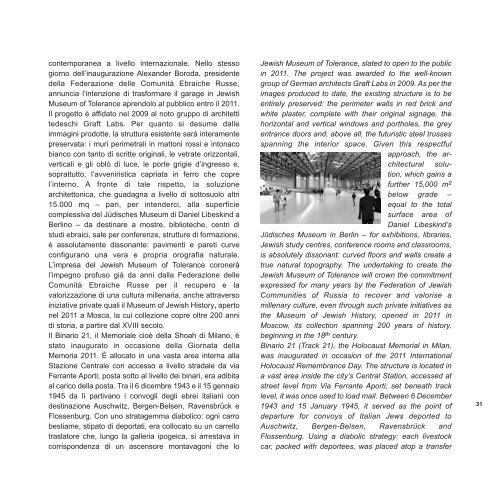Adachiara Zevi - arteinmemoria
Adachiara Zevi - arteinmemoria
Adachiara Zevi - arteinmemoria
You also want an ePaper? Increase the reach of your titles
YUMPU automatically turns print PDFs into web optimized ePapers that Google loves.
contemporanea a livello internazionale. Nello stesso<br />
giorno dell’inaugurazione Alexander Boroda, presidente<br />
della Federazione delle Comunità Ebraiche Russe,<br />
annuncia l’intenzione di trasformare il garage in Jewish<br />
Museum of Tolerance aprendolo al pubblico entro il 2011.<br />
Il progetto è affidato nel 2009 al noto gruppo di architetti<br />
tedeschi Graft Labs. Per quanto si desume dalle<br />
immagini prodotte, la struttura esistente sarà interamente<br />
preservata: i muri perimetrali in mattoni rossi e intonaco<br />
bianco con tanto di scritte originali, le vetrate orizzontali,<br />
verticali e gli oblò di luce, le porte grigie d’ingresso e,<br />
soprattutto, l’avveniristica capriata in ferro che copre<br />
l’interno. A fronte di tale rispetto, la soluzione<br />
architettonica, che guadagna a livello di sottosuolo altri<br />
15.000 mq – pari, per intenderci, alla superficie<br />
complessiva del Jüdisches Museum di Daniel Libeskind a<br />
Berlino – da destinare a mostre, biblioteche, centri di<br />
studi ebraici, sale per conferenze, strutture di formazione,<br />
è assolutamente dissonante: pavimenti e pareti curve<br />
configurano una vera e propria orografia naturale.<br />
L’impresa del Jewish Museum of Tolerance coronerà<br />
l’impegno profuso già da anni dalla Federazione delle<br />
Comunità Ebraiche Russe per il recupero e la<br />
valorizzazione di una cultura millenaria, anche attraverso<br />
iniziative private quali il Museum of Jewish History, aperto<br />
nel 2011 a Mosca, la cui collezione copre oltre 200 anni<br />
di storia, a partire dal XVIII secolo.<br />
Il Binario 21, il Memoriale cioè della Shoah di Milano, è<br />
stato inaugurato in occasione della Giornata della<br />
Memoria 2011. È allocato in una vasta area interna alla<br />
Stazione Centrale con accesso a livello stradale da via<br />
Ferrante Aporti; posta sotto al livello dei binari, era adibita<br />
al carico della posta. Tra il 6 dicembre 1943 e il 15 gennaio<br />
1945 da lì partivano i convogli degli ebrei italiani con<br />
destinazione Auschwitz, Bergen-Belsen, Ravensbrück e<br />
Flossenburg. Con uno stratagemma diabolico: ogni carro<br />
bestiame, stipato di deportati, era collocato su un carrello<br />
traslatore che, lungo la galleria ipogeica, si arrestava in<br />
corrispondenza di un ascensore montavagoni che lo<br />
Jewish Museum of Tolerance, slated to open to the public<br />
in 2011. The project was awarded to the well-known<br />
group of German architects Graft Labs in 2009. As per the<br />
images produced to date, the existing structure is to be<br />
entirely preserved: the perimeter walls in red brick and<br />
white plaster, complete with their original signage, the<br />
horizontal and vertical windows and portholes, the grey<br />
entrance doors and, above all, the futuristic steel trusses<br />
spanning the interior space. Given this respectful<br />
approach, the architecturalsolution,<br />
which gains a<br />
further 15,000 m2 below grade –<br />
equal to the total<br />
surface area of<br />
Daniel Libeskind’s<br />
Jüdisches Museum in Berlin – for exhibitions, libraries,<br />
Jewish study centres, conference rooms and classrooms,<br />
is absolutely dissonant: curved floors and walls create a<br />
true natural topography. The undertaking to create the<br />
Jewish Museum of Tolerance will crown the commitment<br />
expressed for many years by the Federation of Jewish<br />
Communities of Russia to recover and valorise a<br />
millenary culture, even through such private initiatives as<br />
the Museum of Jewish History, opened in 2011 in<br />
Moscow, its collection spanning 200 years of history,<br />
beginning in the 18th century.<br />
Binario 21 (Track 21), the Holocaust Memorial in Milan,<br />
was inaugurated in occasion of the 2011 International<br />
Holocaust Remembrance Day. The structure is located in<br />
a vast area inside the city’s Central Station, accessed at<br />
street level from Via Ferrante Aporti; set beneath track<br />
level, it was once used to load mail. Between 6 December<br />
1943 and 15 January 1945, it served as the point of<br />
departure for convoys of Italian Jews deported to<br />
Auschwitz, Bergen-Belsen, Ravensbrück and<br />
Flossenburg. Using a diabolic strategy: each livestock<br />
car, packed with deportees, was placed atop a transfer<br />
31


